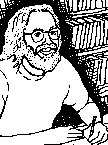Thursday: Law of Justice and Peace
Again today we had two talks that gave fundamentally different visions of the Law of Justice and Peace designed to reintegrate demobilized paramilitaries into society.
First we met with Jenny Claudia Almeida, a lawyer with the justice and peace section of the attorney general’s office. She painted a picture of a 40-year conflict in Colombia as a result of drug trafficking, with the paramilitary forming as a conservative reaction to left-wing guerrillas. The Law of Justice and Peace was promulgated one and a half years ago as Uribe’s attempt to find a political solution to the country’s conflict. Almeida emphasized that the law comes out of the will of the paramilitary to accept the law. Their punishment is relatively light (often 5 years in jail), but in exchange they must leave their armed group, come completely clean on their actions, and turn over their property. The attorney general’s office is constructing a massive database to document and verify paramilitary actions, and to cross check stories. Almeida gave a rather emotional presentation, stating that she was personally tired of death and the compromises of this law were worth it to have peace. Investigating these cases was like taking the lid off of a pot, as increasingly more information came out. Almeida was professional but also appeared passionately committed to her work, even while admitting that the law was politically motived by Uribe’s interests.
We then met with Luis Jairo Ramírez who painted an entirely different image of this law. Rather than rooting the conflict in drug trafficking, which is a recent phenomenon, Ramírez traced it back to the Spanish conquest 500 years ago. A new cycle emerged in the 1940s with a consolidation of the dominate culture that excluded popular sectors, leading to the emergence of guerrilla groups to defend peasant interests. Paramilitaries emerged in the 1960s not as a third armed actor, but as an integral part of the state. Financed by drug trafficking, land owners, elite economic interests, and multinational corporations, the paramilitaries engaged in a dirty war. Paramilitary leaders claimed that they would disappear when the guerrillas did, but the recent history of demobilization with the guerrillas still in action casts doubt that this was the objective. Rather, paramilitary actions led to an extreme concentration of land ownership, in reality a reverse agrarian reform. Furthermore, their goal was to liquidate civilian opposition, in particular a genocidal war against union leaders. In contrast to Almeida, Ramírez painted the Law of Justice and Peace as a sham, as an amnesty to forgive crimes without requiring any serious punishment, reparations, or structural changes. It was a law of impunity. Furthermore, it was a misnomer to label this a peace process because peace is negotiated between adversaries and not among friends, as was the case with Uribe and the paramilitary that never attacked his government or economic interests. Ramírez called for a true peace agreement not so that everything stays the same, but so that things change.

